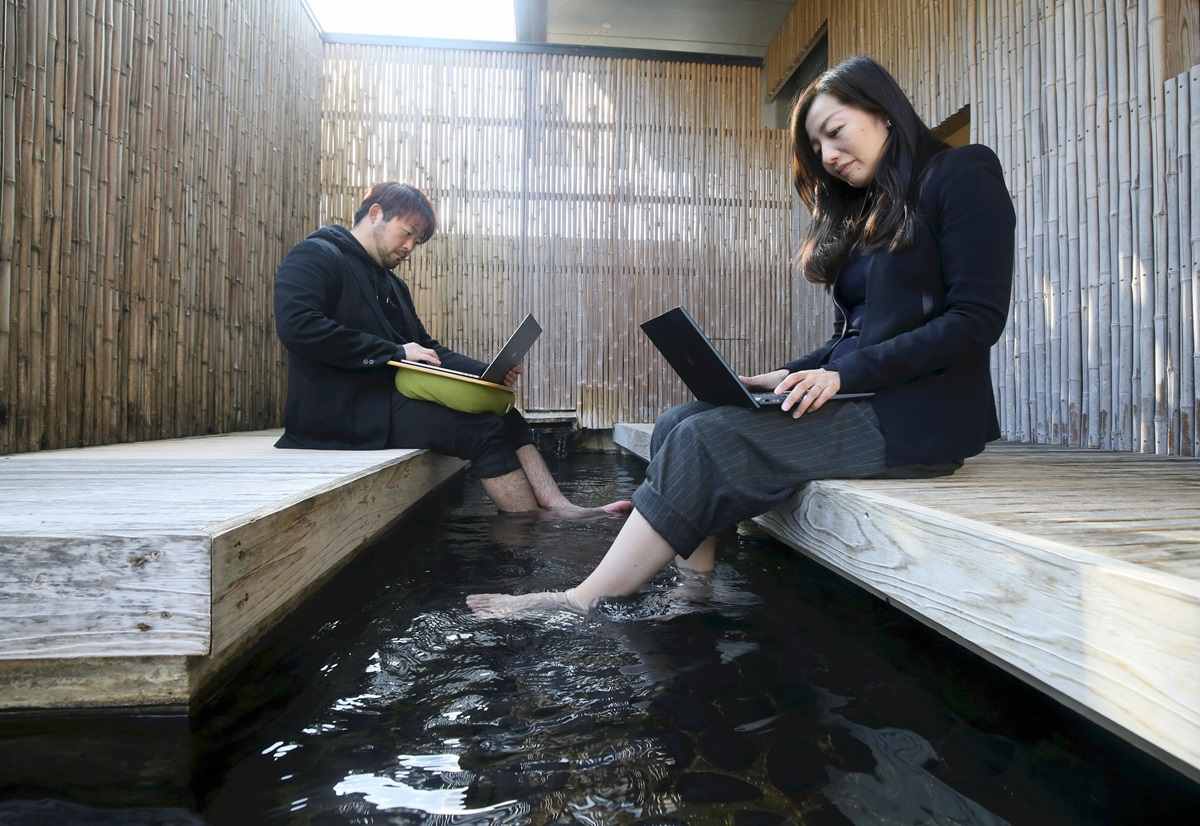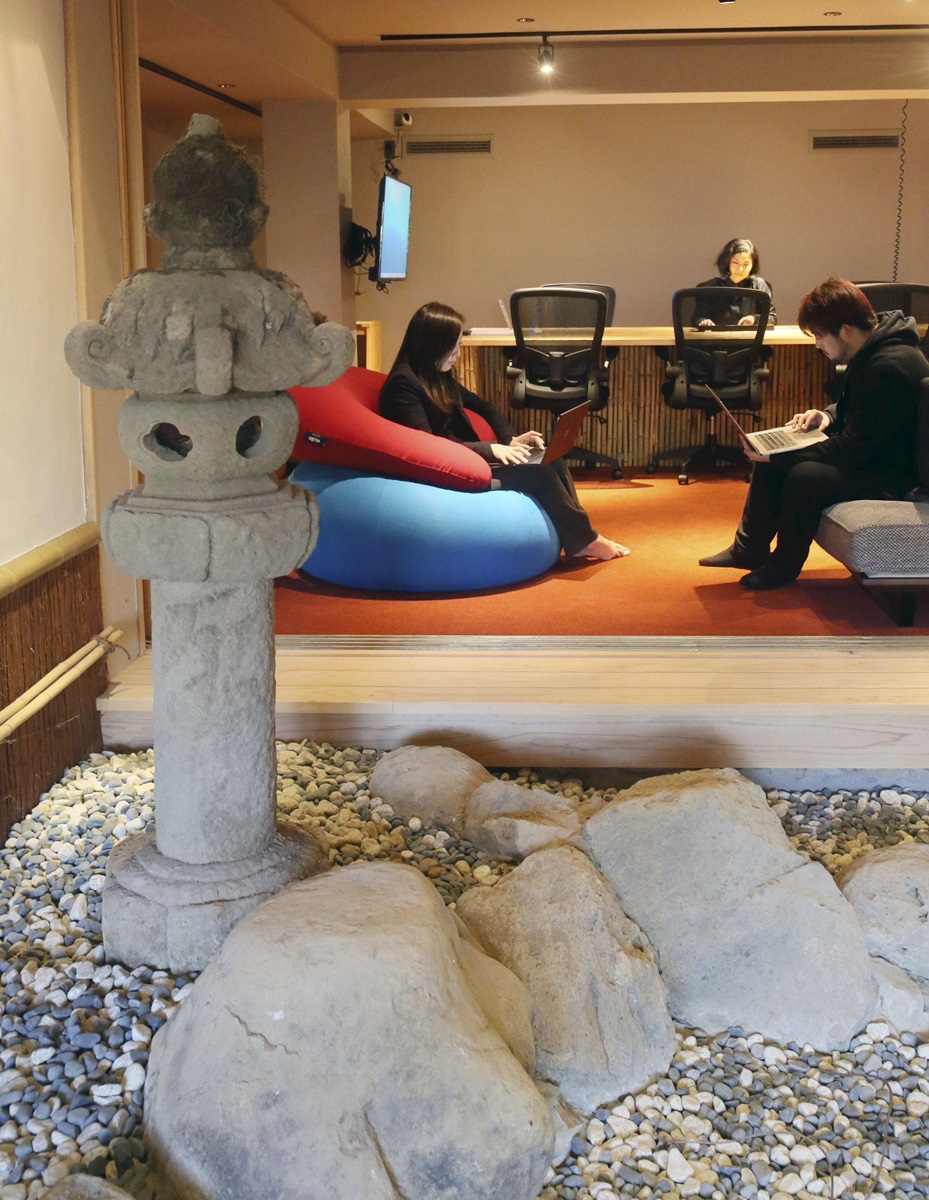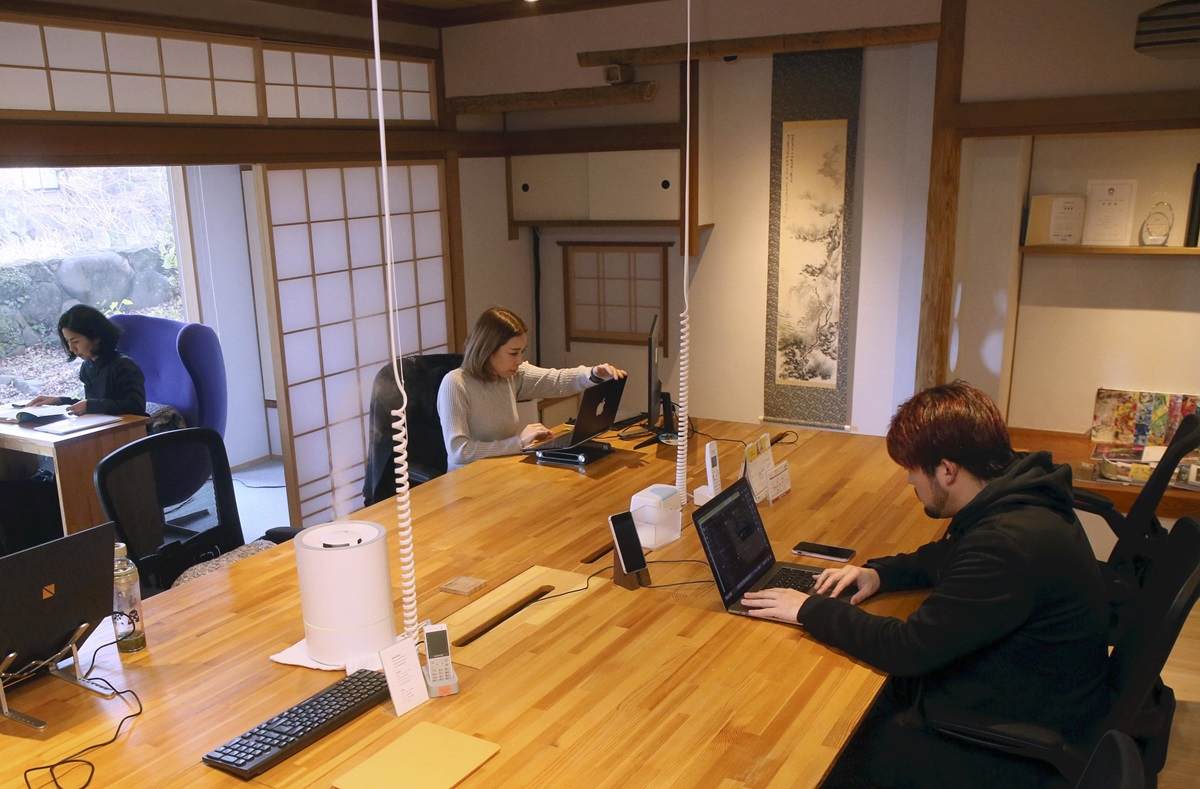Saga: Ryokan Japanese Inns with Hot Springs Offering Office Spaces to Remote Workers; Increasing Productivity

Ayano Nire, right, works on a computer while enjoying the footbath at Wataya Besso in Ureshino, Saga Prefecture.
16:05 JST, February 24, 2024
URESHINO, Saga — As working from remote locations at tourist resorts and other vacation destinations is attracting attention, efforts to turn hot spring inns into offices are spreading.
Wataya Besso, a long-established ryokan inn in Ureshino, Saga Prefecture, is one of the first inns in the nation to adopt the work-at-ryokan system, and their efforts have been hailed as the “Ureshino model.”
The inn has been in the spotlight since April 2020 when the nation was suffering from the coronavirus pandemic, with 11 companies from the Tokyo metropolitan area and elsewhere using the inn and about 1,000 people visiting the ryokan in study tours annually.
Accompanied by the sound of a stream and a chorus of birdsong, Ayano Nire, 36, was working before a monitor in a room that used to be a guest room at Wataya Besso in mid-January. Nire is an employee of Innovation Partners Inc., a Tokyo-based promotion company for tourist resort revitalization projects. Wataya Besso at the Ureshino Onsen hot spring resort is serving as the company’s Asia head office.

People work in an office that was renovated from a guest room.
“The smell of the wood makes me feel relaxed. I also get more work done here,” Nire said.
About eight of the company’s approximately 20 employees work at the ryokan. They can take a bath in the hot springs whenever they want, and there is a cafeteria for ryokan employees that can also be used.
Nire was hired in Tokyo on the condition of moving to the area after employment and has been working in Ureshino since January. She gets into the hot spring whenever she gets stuck in her thoughts and often comes up with ideas while talking with employees of other companies at a shared common space, she said.
“There is something about ryokan that makes people more friendly,” Nire said.

New business model
Ureshino hot spring water is said to help produce beautiful skin, and Wataya Besso, established in 1950, has an area of about 66,000 square meters. When Yoshimoto Kohara, 47, became president of the ryokan in 2013, he felt that his inn was not making the most of the rich local assets including the hot spring, tea and pottery, which are among the best in Japan.
After Innovation Partners suggested renting out some of its spaces as offices, Kohara began seeking a way to depart from the conventional ryokan business model.
Wataya Besso, which used to receive more than 100,000 overnight visitors a year, suffered financially after the outbreak of the coronavirus pandemic in 2020 and was in such a slump that it had only two guests a day. There were many days when its 130 guest rooms and 25 banquet rooms were not used.

Shoji paper screens and hanging scrolls in a tokonoma alcove retain the atmosphere of a hot spring ryokan guest room.
“I realized how fragile the ryokan industry was,” Kohara said.
The experience prompted Kohara to try the renting idea. In April 2020, he began renting out some of the renovated guest rooms. Their monthly rent varies depending on the size of the room, with a room costing as much as ¥800,000. There is also a room for ¥200,000 per month for startups.
Partly thanks to the municipal government’s subsidy program, a Tokyo-based web production company and 10 other firms set up their offices at Wataya Besso. This led to the creation of about 50 jobs locally.
Wataya Besso’s efforts garnered attention as a new way to attract enterprises to local areas and a novel way of working. It has received over 3,000 visitors over the past three years from central and local governments as well as companies.
Model expanding to other resorts
The central government is calling for companies to allow more employees to work remotely at tourist spots or vacation destinations since such a working environment is expected to help reduce stress, improve motivation and increase productivity.
The Ureshino model is beneficial to hotels as well as inns as they can generate stable revenues.
For that reason, the Ureshino model is spreading to various locations, including long-established ryokan inns in the hot spring resort of Gamagori, Aichi Prefecture, and a ski resort hotel in Myoko, Niigata Prefecture.
“It’s more comfortable to work at this ryokan than in any other office building in the Tokyo metropolitan area. We also have the hot spring,” Kohara said.
“We aim to offer even more high value services.”
Related Tags
"Features" POPULAR ARTICLE
-

Sanrio to Open Museum in Yamanashi Pref. Dedicated to Founder, Exhibits Include Hello Kitty, Other Characters
-

Autumn Foliage Surrounds Visitors to Tokyo’s Showa Kinen Park
-

My Daughter No Longer Speaks to Me, But I Want to See Her and My Grandchild
-

Kumamoto: Public Bath Refurbished as Library Where You Can Chat, Take Photos
-

Frozen Vegetables: Demand Rises for Convenient, Tasty Domestic Produce
JN ACCESS RANKING
-

Tokyo Economic Security Forum to Hold Inaugural Meeting Amid Tense Global Environment
-

Keidanren Chairman Yoshinobu Tsutsui Visits Kashiwazaki-Kariwa Nuclear Power Plant; Inspects New Emergency Safety System
-

Imports of Rare Earths from China Facing Delays, May Be Caused by Deterioration of Japan-China Relations
-

University of Tokyo Professor Discusses Japanese Economic Security in Interview Ahead of Forum
-

Japan Pulls out of Vietnam Nuclear Project, Complicating Hanoi’s Power Plans

























